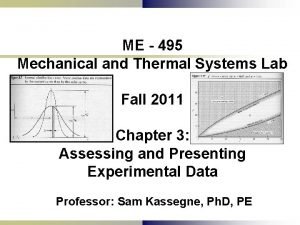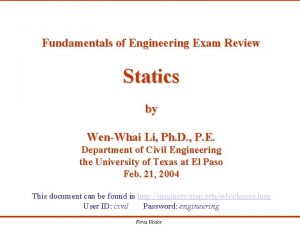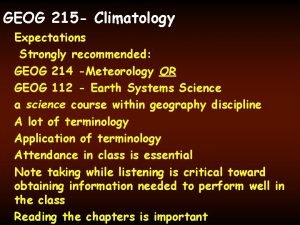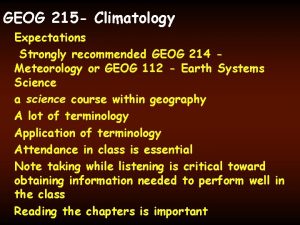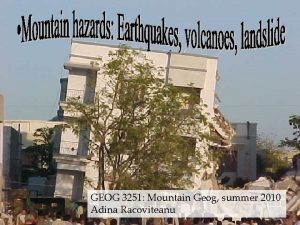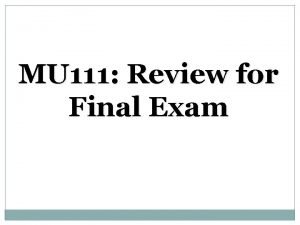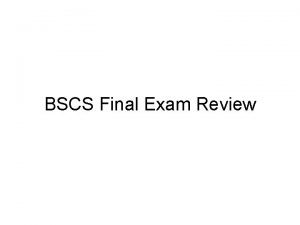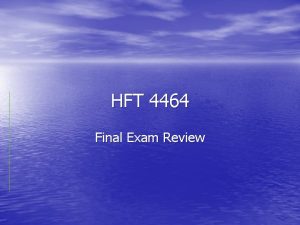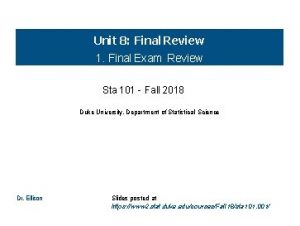Geog 495 Final Exam Review 112305 Final exam






















- Slides: 22

Geog 495 Final Exam Review 11/23/05 Final exam on 11/28/05 Mon

Outlines I. Big picture – Attribute – Space – Attribute & Space II. Small picture – GIS view on spatial data – DBMS view on spatial data III. Synthesis

I. Big picture • Geographic information has three main components: space, time, and attribute • Traditionally the representation of attribute is well studied in contrast to space and time • How attribute is represented in computer database model (first half of this course) • How space is represented in computer spatial data model (second half of this course) • How space is combined with attribute – In GIS (GIS Architecture) – In DBMS (SDBMS Architecture) – Integration of GIS with DBMS

Database model • • • Hierarchical Network Relational Object-oriented Object-relational

Spatial data model • Object view • Field view

GIS architecture • Hybrid • Purely relational • Object-oriented or object-relational File-system into database system

SDBMS architecture • Purely relational • Object-oriented • Object-relational Accommodated into spatial semantics

Integrating GIS with SDBMS • GIS-centered – e. g. Arc/Info ODBC – What’s the relative advantage of this approach? • SDBMS-centered – e. g. Oracle Spatial – What’s the relative advantage of this approach?

GIService • Utilize specialized GIS functionalities that meet specific needs • Built upon DBMS • Somewhat eclectic: good things from both

II. Small picture • Two views on spatial data model • GIS view: focused on how to store spatial information suited to application needs (e. g. building topology for routing applications) • SDBMS view: focused on how to store spatial information suited to SQL-like queries (e. g. defining spatial data type, spatial operators)

1. GIS view on spatial data • Data hierarchy Human thinking – Data model: how spatial concepts are viewed – Data structure: how spatial information in stored in computer Level of abstraction – Data format: how data structure is stored in s/w specific format Machine code

Data model • There are two common views • Object-view – The world is composed of discrete entities • Field-view – The world is composed of continuous fields • Both coexists in the real-world • One phenomenon can be represented in two views • Human perception tends to discretize information also

Data structure • Data structure that stores spatial information – Vector: composed of (a set of) point – Raster: composed of grid cell • Data structure that stores attributes derived from spatial relationships – TIN: connected network of points whose attributes vary – Matrix: represent attributes based on a pair of spatial objects

Do you know? • Vertice, node, point, line, polygon, multishape polygon, multistring…. • Topology vs. spaghetti model • Planar vs. non-planar • Compression methods for raster data structure – Run-length code – Quadtree

File format • Different systems use different file formats • Needs for interoperability – How can we promote interoperability? • Metadata – Metadata standard? – What kind of information is documented? – FGDC standard

Do you know? • • SDTS XML Open GIS Characteristics of specific file format and how they are classified into different data model? – TIGER/Line – DEM – Mr. SID, BIL, Geo. Tiff (These are common DOQ format)

2. DBMS view on spatial data • Spatial data type • Spatial operators

Spatial data type • Object – Point sets – Do you know OGIS spatial object types? • Field – Tessellation (grid) representation – No too much work has been done

Spatial operators • On field-based data – Local (e. g. +, -, …) – Focal (e. g. gradient) – Zonal (e. g. average) • On object-based data – Topological (e. g. within, overlap, touch) – Metric (e. g. distance, direction, area)

Miscellaneous • What is spatial access method (or spatial indexing)? – Quadtree vs. R tree • Query processing – Single scan vs. multi scan

III. Synthesis • More DBMS approach to GIS is desirable – DB system is superior to file system – DB gets increasingly smarter – Distributed GIS environment gets increasingly popular

• Inadequacy of RDB to representing spatial concepts should be accommodated – User-defined spatial data types – User-defined spatial operators – Custom data model (refer to next week presentation on geodatabase case studies) – Geographer’s role formalizing spatial concepts (Naïve geography? )
 Uncontrollable spending ap gov
Uncontrollable spending ap gov Cmse 495
Cmse 495 Energy in thermal system lab report politeknik
Energy in thermal system lab report politeknik Opwekking 495
Opwekking 495 Steganography android
Steganography android World history spring final exam review answers
World history spring final exam review answers Spanish 1 final exam review packet answer key
Spanish 1 final exam review packet answer key Pltw human body systems final exam
Pltw human body systems final exam Poe practice test answer key
Poe practice test answer key Ied final exam review
Ied final exam review World history first semester exam review
World history first semester exam review Entrepreneurship 1 final exam review
Entrepreneurship 1 final exam review Spanish 2 review packet answers
Spanish 2 review packet answers Environmental science final
Environmental science final World history final exam review
World history final exam review Us history semester 2 final exam review
Us history semester 2 final exam review English 11 a semester exam
English 11 a semester exam Physics fall final exam review
Physics fall final exam review Physical science final exam
Physical science final exam Mat 1033 final exam answers
Mat 1033 final exam answers Fe exam statics review
Fe exam statics review Zoology semester 1 exam review answers
Zoology semester 1 exam review answers Earth science final exam
Earth science final exam


